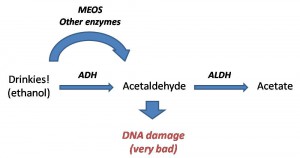This is great news for all of us drinkers. And, frankly, if I was just a little better at actual chemistry, how I’d make my first couple of fortunes*
And now I have the song ‘Tiny Bubbles‘ stuck, unfortunately, in my head. (When I first heard it, though, it was an Aero jingle. Possibly)
So yes. To give it to you simply, before going into all that explanation stuff, it’s very simple - loading more dissolved oxygen into alcohol apparently removes some of the side-effects of drinking it. But more on those details later.
Firstly, a brief lesson in how the body processes alcohol. Metabolically, that is, not in the sense of ‘it makes you do silly things and lose control over your joints’.
So…Shortly after the imbibing thereof, alcohol gets almost completely absorbed into your bloodstream. By shortly, I mean that about 30-90 min after you’ve had that drink, its goodness has peaked in your blood. And then needs to be got rid of. It is, after all, a toxin.
In order to do this, a few different enzymes are needed (see diagram below). They include ADH (alcohol dehydrogenase), ALDH (aldehyde dehydrogenase) and MEOS (microsomal ethanol oxidising system). To summarise, they are involved in oxidation of alcohol and the ensuing compounds - this whole process is the primary one used to detoxify alcohol, though not the only one.
Particularly scary, the intermediate phase of the breakdown process, acetaldehyde, causes DNA damage***. Not, as I’m sure you agree, a good thing.
But moving along. As you may have guess from the liberal use of words beginning with ‘ox-‘, oxygen is of primary importance in this process. And, in fact, the more oxygen there is around, the faster the process is able to happen. Also, it would appear to produce ‘major elevations’ in enzymes which are involved in protecting against alcoholic liver damage. Another good thing (my, but aren’t we racking them up).
So, where does all this oxygen come from? Well, from breathing, and also through our skin and gut. Interestingly, the liver gets the vast majority of its oxygen from the gut directly. To quote the paper:
Oxygen for ethanol oxidation is supplied through breathing, the stomach, and the skin. Gastroenteric oxygen intake (via the stomach) is more intensive than breathing and supplies oxygen to muscle cells and can be involved in regenerative processes. Additionally, oxygen-enriched water, supplied to the stomach, affects the oxygenation of portal blood. Breathing increases the oxygen content in the liver by 8%, while oxygen absorbed through the stomach can increase it by 43% (Forth and Adam, 2001). (My emphasis)
On to the experiment. In essence, they fed alcoholic beverages (with the prior, written consent of their subjects, although why this would be necessary I don’t know. Free drinks!) containing different amounts of dissolved oxygen to their test subjects. Slash new best friends. And they noticed that it took significantly less time for the BAC (blood alcohol concentration) to drop in people fed higher-oxygen drinks. Further, looking at the detailed results (available in the paper), it would appear that this oxygen affects the bits where the alcohol is metabolised/eliminated, not absorbed.
And so, after all this, I shall answer the question hovering on your lips; ‘but what does this actually mean?’
Well, it means that you can still get happily tipsy and/or drunk. But, and this is wonderful, you’ll sober up faster, which is good news for traffic- and other drinking-related accidents. Also, hopefully it might mean that less DNA damage takes place.
Hooray!
On a separate, but linked note: DNA damage is not, it would seem, permanent nor even particularly difficult to fix (in some cases, at least). We all sustain and accrue DNA damage as we go through our lives, and this damage is of course implicated in ageing and age-related diseases. But a field of study called nutrigenomics looks at how our diets interact with our genotypes at that level. And some of the work done (for example by Dr Michael Fenech) is suggesting that simply feeding our bodies the correct micronutrients can go a long way towards fixing this damage. Of course it’s different for each individual, before you all go charging off to buy millions of supplements.
* Note: anyone who copies my idea automatically accepts me as partner to the enterprise. Also, I know bus. strat/marketing/research etc. I’d be perfect…
** Diagram, and knowledge of DNA damage, happily from Dr Michael Fenech (with diagram doubly referenced as Boffetta and Hashibe Lancet 2006 and Morimoto et al 1993).
Reference:
In-hwan Baek, Byung-yo Lee, and Kwang-il Kwon (2010). Influence of Dissolved Oxygen Concentration on the Pharmacokinetics of Alcohol in Humans
Alcoholism: Clinical and Experimental Research : 10.1111/j.1530-0277.2010.01155.x



Pingback: ENERGy!!!!!?()
Pingback: How To Lower High Triglycerides Naturally? | Pinellas Real Estate Appraiser()